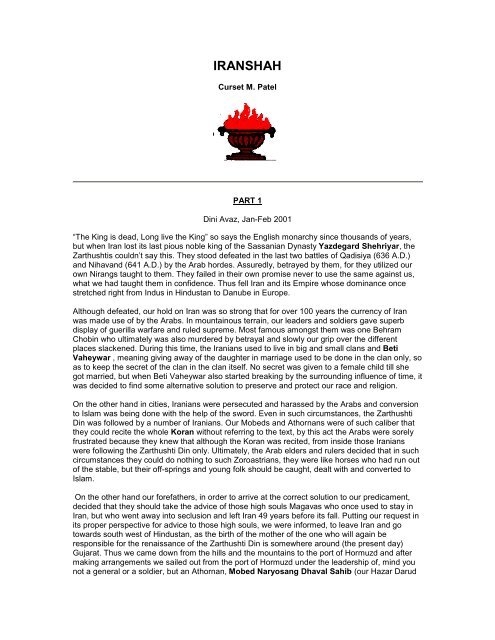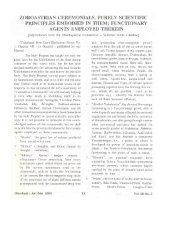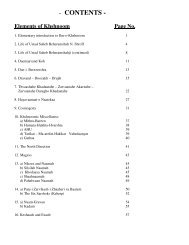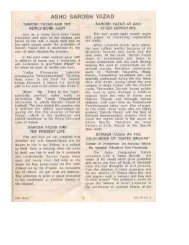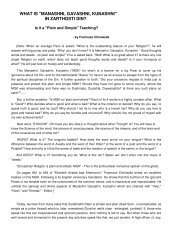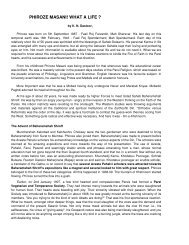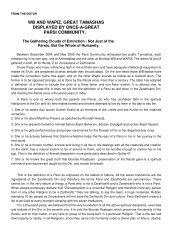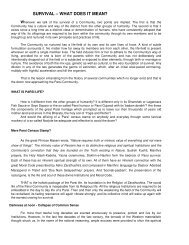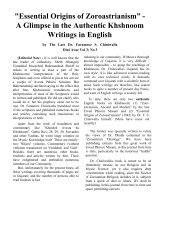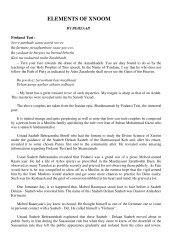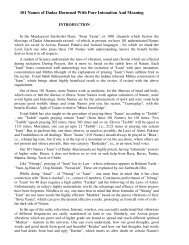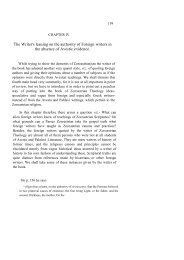IRANSHAH - Traditional Zoroastrianism: Tenets of the Religion
IRANSHAH - Traditional Zoroastrianism: Tenets of the Religion
IRANSHAH - Traditional Zoroastrianism: Tenets of the Religion
Create successful ePaper yourself
Turn your PDF publications into a flip-book with our unique Google optimized e-Paper software.
<strong>IRANSHAH</strong><br />
Curset M. Patel<br />
PART 1<br />
Dini Avaz, Jan-Feb 2001<br />
“The King is dead, Long live <strong>the</strong> King” so says <strong>the</strong> English monarchy since thousands <strong>of</strong> years,<br />
but when Iran lost its last pious noble king <strong>of</strong> <strong>the</strong> Sassanian Dynasty Yazdegard Shehriyar, <strong>the</strong><br />
Zarthushtis couldn’t say this. They stood defeated in <strong>the</strong> last two battles <strong>of</strong> Qadisiya (636 A.D.)<br />
and Nihavand (641 A.D.) by <strong>the</strong> Arab hordes. Assuredly, betrayed by <strong>the</strong>m, for <strong>the</strong>y utilized our<br />
own Nirangs taught to <strong>the</strong>m. They failed in <strong>the</strong>ir own promise never to use <strong>the</strong> same against us,<br />
what we had taught <strong>the</strong>m in confidence. Thus fell Iran and its Empire whose dominance once<br />
stretched right from Indus in Hindustan to Danube in Europe.<br />
Although defeated, our hold on Iran was so strong that for over 100 years <strong>the</strong> currency <strong>of</strong> Iran<br />
was made use <strong>of</strong> by <strong>the</strong> Arabs. In mountainous terrain, our leaders and soldiers gave superb<br />
display <strong>of</strong> guerilla warfare and ruled supreme. Most famous amongst <strong>the</strong>m was one Behram<br />
Chobin who ultimately was also murdered by betrayal and slowly our grip over <strong>the</strong> different<br />
places slackened. During this time, <strong>the</strong> Iranians used to live in big and small clans and Beti<br />
Vaheywar , meaning giving away <strong>of</strong> <strong>the</strong> daughter in marriage used to be done in <strong>the</strong> clan only, so<br />
as to keep <strong>the</strong> secret <strong>of</strong> <strong>the</strong> clan in <strong>the</strong> clan itself. No secret was given to a female child till she<br />
got married, but when Beti Vaheywar also started breaking by <strong>the</strong> surrounding influence <strong>of</strong> time, it<br />
was decided to find some alternative solution to preserve and protect our race and religion.<br />
On <strong>the</strong> o<strong>the</strong>r hand in cities, Iranians were persecuted and harassed by <strong>the</strong> Arabs and conversion<br />
to Islam was being done with <strong>the</strong> help <strong>of</strong> <strong>the</strong> sword. Even in such circumstances, <strong>the</strong> Zarthushti<br />
Din was followed by a number <strong>of</strong> Iranians. Our Mobeds and Athornans were <strong>of</strong> such caliber that<br />
<strong>the</strong>y could recite <strong>the</strong> whole Koran without referring to <strong>the</strong> text, by this act <strong>the</strong> Arabs were sorely<br />
frustrated because <strong>the</strong>y knew that although <strong>the</strong> Koran was recited, from inside those Iranians<br />
were following <strong>the</strong> Zarthushti Din only. Ultimately, <strong>the</strong> Arab elders and rulers decided that in such<br />
circumstances <strong>the</strong>y could do nothing to such Zoroastrians, <strong>the</strong>y were like horses who had run out<br />
<strong>of</strong> <strong>the</strong> stable, but <strong>the</strong>ir <strong>of</strong>f-springs and young folk should be caught, dealt with and converted to<br />
Islam.<br />
On <strong>the</strong> o<strong>the</strong>r hand our forefa<strong>the</strong>rs, in order to arrive at <strong>the</strong> correct solution to our predicament,<br />
decided that <strong>the</strong>y should take <strong>the</strong> advice <strong>of</strong> those high souls Magavas who once used to stay in<br />
Iran, but who went away into seclusion and left Iran 49 years before its fall. Putting our request in<br />
its proper perspective for advice to those high souls, we were informed, to leave Iran and go<br />
towards south west <strong>of</strong> Hindustan, as <strong>the</strong> birth <strong>of</strong> <strong>the</strong> mo<strong>the</strong>r <strong>of</strong> <strong>the</strong> one who will again be<br />
responsible for <strong>the</strong> renaissance <strong>of</strong> <strong>the</strong> Zarthushti Din is somewhere around (<strong>the</strong> present day)<br />
Gujarat. Thus we came down from <strong>the</strong> hills and <strong>the</strong> mountains to <strong>the</strong> port <strong>of</strong> Hormuzd and after<br />
making arrangements we sailed out from <strong>the</strong> port <strong>of</strong> Hormuzd under <strong>the</strong> leadership <strong>of</strong>, mind you<br />
not a general or a soldier, but an Athornan, Mobed Naryosang Dhaval Sahib (our Hazar Darud
Afarin on him) who brought 2002 Zarathoshti men, women and children toge<strong>the</strong>r with o<strong>the</strong>r eight<br />
spiritually exalted Mobeds, safe and sound at Diu, in gulf <strong>of</strong> Cambay <strong>of</strong> Hindustan. Staying in Diu<br />
for 19 years, we left its shores and sailed fur<strong>the</strong>r down southwards as ordained till we came to<br />
Sanjan.<br />
Many <strong>of</strong> us are aware <strong>of</strong> <strong>the</strong> incident <strong>of</strong> our voyage and landing and subsequent talk with <strong>the</strong><br />
Sanjan King Jadiv Rana except some few points which will be emphasized here whilst going<br />
through in a nutshell <strong>the</strong> well known part <strong>of</strong> <strong>the</strong> story.<br />
Whilst voyaging towards Sanjan we ran into a storm at sea. It was a heavy storm lashed by rain<br />
and getting worse by <strong>the</strong> minute which could capsize <strong>the</strong> boat but not getting perturbed, our<br />
leader Naryosang Dhaval Sahib performed Kusti Padyab and instructed all o<strong>the</strong>rs to follow suit.<br />
Gradually <strong>the</strong> storm died down and waves abetted when as thanksgiving all decided that <strong>the</strong>y<br />
would build an Atash Behram when <strong>the</strong>y would settle down on land.<br />
On landing at Sanjan, we sought for permission to enter <strong>the</strong> city. In reply to this <strong>the</strong> King <strong>of</strong><br />
Sanjan Jadiv Rana sent us a vessel full <strong>of</strong> milk without any verbal or written message. This was<br />
to convey to us that his city was full and he had no place to accommodate us. Also, it was a kind<br />
<strong>of</strong> test <strong>of</strong> our intellectual powers, as to how we would interpret his reply and in turn what we would<br />
do? The noble king Jadiv Rana was unaware <strong>of</strong> <strong>the</strong> status (so many Parsees are still unaware <strong>of</strong><br />
Naryosang Dhaval being a six Kash Ashvan which is explained later) <strong>of</strong> Mobedan Mobed<br />
Naryosang Dhaval who was an Ashvan and that too Six Kash Ashvan , who took no time in<br />
understanding <strong>the</strong> whole message and at once took out from his finger a diamond studded gold<br />
ring and without saying anything, quietly slipped it into <strong>the</strong> pot <strong>of</strong> milk without spilling any milk and<br />
gesturing <strong>the</strong> bearer to go back to <strong>the</strong> King. Our reply to Jadiv Rana was that although your<br />
country is full, we who are like gold, will stay in <strong>the</strong> corner without troubling anybody as this ring<br />
which is lying in <strong>the</strong> milk, sitting at <strong>the</strong> bottom <strong>of</strong> <strong>the</strong> pot, Here it should be noted that it was not<br />
<strong>the</strong> sugar which many quote which was kept informing <strong>the</strong> Rana that we will mix with your people<br />
and as this sugar makes this milk sweet, so we will be with your country. One can ask a question<br />
to those who advocate and insists that it was sugar, that like sugar, if we wanted to mix (in milk)<br />
<strong>the</strong>n why was it necessary to come so many thousands <strong>of</strong> miles, we could have got mixed in Iran<br />
only. Sugar <strong>the</strong>ory seems to be supported by those who are in favour <strong>of</strong> mixed marriages or<br />
those not understanding <strong>the</strong> interpretation <strong>of</strong> <strong>the</strong> sugar and milk.<br />
The court <strong>of</strong> Rana was greatly pleased by our reply and Jadiv Rana at once ordered <strong>the</strong> court<br />
astrologer to find out about us, and give a reading. He also invited Naryosang Dhaval Sahib to<br />
visit his court with his selected Deputies. It should be noted here that we had not laid down arms<br />
after our defeat and used to carry swords, knives, guraj etc. Also, our Iranian forefa<strong>the</strong>rs were not<br />
Lilliputians but tall, fair and handsome and <strong>the</strong> personality <strong>of</strong> Naryosang Dhaval Sahib was aweinspiring<br />
as he was a spiritually advanced soul. His entry made Jadiv Rana sit up, and his<br />
rendering in Sanskrit <strong>the</strong> 16 points in answer to <strong>the</strong> Rana s question as to who we were, what<br />
were our ways <strong>of</strong> life etc., made a lasting impression on Jadiv Rana which ultimately helped us in<br />
procuring <strong>the</strong> vast land required to start <strong>the</strong> work for consecrating <strong>the</strong> Iranshah .<br />
Ustad Sahib Behramshah even said that Naryosang DhavalSahib gave Jadiv Rana a bottle <strong>of</strong><br />
medicine given to him by <strong>the</strong> Magav Sahibs for <strong>the</strong> skin ailment from which <strong>the</strong> Rana was<br />
suffering and <strong>the</strong> medicine did cure King Jadiv Rana.<br />
The above small sketch <strong>of</strong> history was necessary in order to understand that:<br />
We never came to Hindustan by fluke or luck or as refugee. We came with a premeditated plan<br />
by <strong>the</strong> order and guidance given to us by Magavs.<br />
We came under <strong>the</strong> leadership <strong>of</strong> a Dastoor and not some military personnel and Naryosang<br />
Dhaval Sahib was not an ordinary Athornan but a six Kash Ashavan.
ATASH<br />
PART 2<br />
(DINI-AVAZ Jan-Feb 2001)<br />
The four elements <strong>of</strong> Nature, viz., Fire, Water, Air and Earth play an important part in <strong>the</strong> life <strong>of</strong> a<br />
Zarthushti and Fire is predominant among o<strong>the</strong>r elements. Fire is <strong>the</strong> foundation <strong>of</strong> <strong>the</strong> universe<br />
and omnipresent like <strong>the</strong> lord. There are different fire energies working at different stages in <strong>the</strong><br />
universe on different planes.<br />
It is important to understand what is Atash, i.e. Fire energies and <strong>the</strong>ir status in nature, after<br />
which only one can understand and realize as to why we have Agiaries and Atash Behrams, and<br />
<strong>the</strong> Atash is kept <strong>the</strong>re in a vessel Afargania, (limited amount which it can hold), what function it<br />
performs in nature day after day for a Mazdayasni Zarthushti.<br />
The following chart will give a glimpse <strong>of</strong> <strong>the</strong> function <strong>of</strong> Atash on different planes in <strong>the</strong> universe:<br />
Fire Name <strong>of</strong><br />
Energy Fire<br />
No. Energy Heaven No. Functioning on<br />
1 Atash-e-Shaedan Beyond <strong>the</strong> stage <strong>of</strong> Niru<br />
2 Athro Ahurahe Mazdao Puthra 9 th (Highest) 9 heaven <strong>of</strong> Ahunavar<br />
3 Atash Berezi Savangh 8 th Zodiacal heaven; Anaghra Raochao<br />
4(a) Adar Khurdad (major) 7 th Kaiwan (Saturn)<br />
5 Adar Froba (pure) 6 th Barjis (Jupiter)<br />
6(a) Adar Gushasp (major) 5 th Hasham (Mars)<br />
7(1) Adar Burjin Meher (major) 4 th Khurshid (Sun)<br />
6(b) Adar Gushasp (minor) 3 rd Nahid (Venus)<br />
4(b) Adar Khurdad (minor) 2 nd Tarad (Mercury)<br />
7(b) Adar-I-Burjin Meher (minor) 1 st Mah (Moon)<br />
Fire No. Name <strong>of</strong> Fire Energy<br />
Where Function<br />
8 Adar-e-Mino-Karko<br />
On Aiwi Dakhyu, Antare Dakhyu and Aa Dakhyu region <strong>of</strong> Kurrah (division <strong>of</strong> subtle fire element<br />
and six super e<strong>the</strong>real Keshvars (Note). The fundamental fire energy <strong>of</strong> <strong>the</strong> whole Nisti worlds<br />
(Space).<br />
9(a) Adar-e-Vazishte-latif (higher<br />
On region <strong>of</strong> Kurrah (division) <strong>of</strong> subtle airy element<br />
9(b) Adar-e-Vazishte-Kasif (lower)<br />
On gross airy element and in air. (Note: Subtle air is generated here. From here invisible i.e.<br />
intangible air begins).<br />
10(a) Adar-e-Urvazishte-Latif (higher)<br />
On region <strong>of</strong> Kurrah (division) <strong>of</strong> subtle watery element<br />
10(b) Adar-e-urvazishte-Kasif (lower)<br />
On region <strong>of</strong> Kurrah (division) <strong>of</strong> gross watery element and in vegetable kingdom and in water<br />
and in milk <strong>of</strong> animals.
11(a) Adar-e-Spenishte-Latif (higher)<br />
On region <strong>of</strong> Kurrah (division) <strong>of</strong> subtle material element<br />
11(b) Adar-e-spenishte-Kasif (lower)<br />
On region <strong>of</strong> Kurrah (division) <strong>of</strong> gross material element and in mineral kingdom.<br />
12(a) Adar-e-Vohufryane-Kasif (lower)<br />
In speaking animals, i.e.human beings<br />
12(b) Adar-e-Vohufryane-Kasif (lower)<br />
Dumb animals (lower to higher)<br />
13 Atash-e-Dara<br />
} All four fire-energies<br />
14 Atash-e-Nairyosangh<br />
} co-operating with<br />
} Atash-e-Vohufryan in<br />
15 Atash-e-Khoreh<br />
} in human-<br />
16 Atash-e-Frah<br />
} beings.<br />
(from Khshnoom <strong>of</strong> P.N.Tavaria)<br />
Fire (Asha Vahishta) which is <strong>the</strong> source <strong>of</strong> all creation is equated with Ahura Mazda s own Inner<br />
Light, Divine light, which crosses time and space. The fire which we see is <strong>the</strong> physical<br />
manifestation <strong>of</strong> <strong>the</strong> Divine Light. Ahura Mazda sends His son Fire Athro Ahurae Mazdao<br />
Puthra to <strong>the</strong> Earth, to move forward <strong>the</strong> entire creation to its final goal.<br />
No Zarathushti ritual is complete without <strong>the</strong> presence <strong>of</strong> fire. Fire is worshipped as <strong>the</strong> Holiest <strong>of</strong><br />
Spirit (Yasna 34.4). Formerly every household used to have fire known as Dadgah , which was<br />
maintained from generation to generation. Unfortunately from <strong>the</strong> 20 century this was lost sight <strong>of</strong><br />
and virtually at present <strong>the</strong>re are very few Parsee homes maintaining fire. By this folly <strong>of</strong> ours, <strong>the</strong><br />
connection which existed between each household and Agiary, Atash Behram was severed,<br />
<strong>the</strong>reby closing <strong>the</strong> channel <strong>of</strong> Asare-Roshni , blessings <strong>of</strong> Ahura Mazda, which Agiaries and<br />
Atash Behrams used to pass to Zarathushti houses.<br />
As clay and clay differs indignity so does Atash. As we know, <strong>the</strong>re are different kinds <strong>of</strong> Atash.<br />
By striking a match, we produce Atash, we have household Atash, Dadgah (in Agiary, Atash<br />
Behram), Adaran Atash, Atashe-Vaharan Atash, Lightning Atash, Flying Atash, Underground<br />
preserved Atash, Atash produced by Manthra, Atash <strong>of</strong> Nisti, Hasti, Minoi, Atash energy<br />
contained in us humans etc. etc. The foundation <strong>of</strong> <strong>the</strong> Geti (world) and Shrushti universe is<br />
Atash.<br />
Pav-Mahal or Mino Gas <strong>the</strong> connection between Hasti (Planes <strong>of</strong> light) and Nisti (Planes <strong>of</strong><br />
Matter) and Geti (World) was done by Asho Zarthusht Sahib by utilizing Atashe Mino Karko and<br />
Atashe Burzin Meher which he possessed in him. The very first Atash Behram, named Burzin<br />
Meher was established in Airyanam Vej by Asho Spitman Zarthushti Sahib Himself. From this<br />
itself in future o<strong>the</strong>r Atash Behrams are to be established by performing certain Kriya as taught by<br />
Zarthusht Sahib.
Atash-Parasti contains Ahu-Parasti Ahu which is woven in <strong>the</strong> word Yatha-Ahu-Vairayo , AHU<br />
who is beyond imagination <strong>of</strong> not only mortals but even Yazads Ahu who has Niru meaning<br />
boundless, without limit Minoi light strength, <strong>the</strong> flowing moving manifestation ( Guj. Thenum<br />
vahethum swashsp) is Atash.<br />
From <strong>the</strong> above nutshell explanation <strong>of</strong> Atash, readers may now have some idea in <strong>the</strong>ir<br />
perspective as to <strong>the</strong> status <strong>of</strong> Atash and consecrated Atash <strong>of</strong> Agiary and Atash Behram.<br />
PART 3<br />
(Dini Avaz, Mar.-Apr. 2001)<br />
Six Kash Ashvan Naryosang Dhaval, under whose leadership we came to India, by his skill,<br />
knowledge and spirituality stunned <strong>the</strong> court <strong>of</strong> Jadhiv Rana, who willingly gave to our fore-fa<strong>the</strong>rs<br />
permission to settle down in his kingdom <strong>of</strong> Sanjan. After some time as per our resolution, which<br />
was taken during <strong>the</strong> sea storm whilst coming to Sanjan, that we would build an Atash Behram<br />
when we settled down, Naryosang Dhaval Sahib visited <strong>the</strong> court <strong>of</strong> Jadhiv Rana to obtain land<br />
and permission for establishing <strong>the</strong> Atash Behram.<br />
After hearing Naryosang Dhaval, King Jadhiv Rana gladly consented to <strong>the</strong> proposal whose<br />
terms and conditions as asked by us would remind one <strong>of</strong> <strong>the</strong> story <strong>of</strong> <strong>the</strong> Arab and <strong>the</strong> camel<br />
which we all have learned when we were young, but nothing <strong>of</strong> that sort.<br />
1, We asked for three to four Farsangs <strong>of</strong> land for our work to build an Atash Behram which was<br />
granted.<br />
2. On this land no person <strong>of</strong> Hindu King or <strong>of</strong> any o<strong>the</strong>r caste could come this was granted.<br />
3. Not only that <strong>the</strong>y could not come but <strong>the</strong>ir voice should also not penetrate <strong>the</strong>re lest whilst<br />
during prayers our Nirang would get nullified this too was granted.<br />
It behoves present day Parsee to think what <strong>the</strong>ir forefa<strong>the</strong>rs were, and <strong>the</strong> status <strong>of</strong> Ashavan<br />
Naryosang Dhaval. It becomes also necessary to understand as to who is called Ashavan <strong>the</strong><br />
concept <strong>of</strong> which is far from <strong>the</strong> one which <strong>the</strong> present Parsee community understands.<br />
WHO IS AN ASHAVAN?<br />
In order to understand Ashavan, we must know what is Ashoi.<br />
Ashoi = order, law Divine<br />
A person decides to speak truth, develops habit <strong>of</strong> it, utilizes his faculties to speak only truth, <strong>the</strong>n<br />
that becomes his virtue. A step towards advancement but a person who has become spiritually<br />
advanced has truth as strength - as whatever he speaks happens, Nature does it for him, and<br />
takes payment if need be from his account. In <strong>the</strong> same fashion one who remains away from<br />
seen and unseen Drujis - pollution, he develops Ashoi as virtue (Gun) whereas <strong>the</strong> one who<br />
advances spiritually passes through stringent and difficult ceremonies, different Nahans , different<br />
difficult disciplines, develops Ashoi as strength, that person becomes Ashavan, who can perform<br />
many things which are beyond <strong>the</strong> scope <strong>of</strong> an ordinary man.<br />
There are 72 steps <strong>of</strong> Ashoi, one who comes upto 24 steps is a three Kash Ashavan, upto 48<br />
steps is six Kash Ashavan and 72 steps is nine Kash Ashavan.
What an Ashavan can do:<br />
1. An Ashavan has <strong>the</strong> power to ignite sandalwood arranged in a certain way, whilst reciting para<br />
<strong>of</strong> Usmoi Ujarasva <strong>of</strong> Atash Niyash Manthra.<br />
2. If an Ashavan performs <strong>the</strong> Boi ceremony, <strong>the</strong>n sandalwood kept on <strong>the</strong> chamach at <strong>the</strong> brink<br />
<strong>of</strong> an Afargania , jumps by itself into <strong>the</strong> fire, he has not to lift his hand to put it in <strong>the</strong> fire as is<br />
done normally by Dastoorjis.<br />
3. Three Kash Ashavan can draw Kash on land meaning, create an invisible barrier between<br />
himself and <strong>the</strong> outside world so outside pollution will not enter into his abode like Demavand Koh<br />
Magav Sahibs <strong>the</strong>y can see us, but we cannot see <strong>the</strong>m.<br />
4. An advanced Ashavan can appear at nine different places at one and <strong>the</strong> same time and can<br />
talk, instruct, etc.<br />
5. The constitution <strong>of</strong> ours and Ashavan’s body is <strong>the</strong> same but <strong>the</strong> Ashavan has exalted his<br />
body and hence he eats and drinks very little, all <strong>of</strong> which he digests and assimilates in his body<br />
and does not develop stool in his intensines.<br />
6. Six Kash Ashavan can draw Kash even on water. If he wishes he can create a new Pav Mahal.<br />
According to his wishes he can change <strong>the</strong> views <strong>of</strong> o<strong>the</strong>rs, can make <strong>the</strong> one who opposes him<br />
sing his praise. Poison like cyanide has no effect on him, he can convert Kharsfaster like lion,<br />
tiger, snake into docile and innocent lamb; daggers, knife can pass through his body without<br />
making a wound it’s just like thrusting a knife in water. If he so desires, he can change arvahi like<br />
Genie, Fairy, giant into his obeying servant and get his work done from <strong>the</strong>m, for which, as<br />
payment accordingly advance <strong>the</strong>m in spiritual progress during <strong>the</strong>ir life-time.<br />
7. Three Kash Ashavan gets <strong>the</strong> last attack on him from Satan in <strong>the</strong> form <strong>of</strong> a beautiful<br />
irresistible woman during which it becomes difficult for him to stand alone, which a six Kash<br />
Ashavan comes to know <strong>of</strong> it, and comes to his help to repel <strong>the</strong> onslaught.<br />
8. Advance Ashavan can give a Nahan to ano<strong>the</strong>r without using any water.<br />
9. Ashavan, if he so desires, can take out from his body <strong>the</strong> perfume <strong>of</strong> Roses, Mogra, etc.<br />
10. An Ashavan when he sits to perform his long Yasna ceremony in order to be absolutely sure<br />
knots his intestine in such a way that he is not in a position to pass wind because during Kriya if<br />
wind passes, <strong>the</strong> ceremonies become nullified and it is to be performed again.<br />
One who has passed all <strong>the</strong> 72 steps <strong>of</strong> Ashoi is called Nine Kash Ashavan and <strong>the</strong>y can be only<br />
<strong>of</strong> Chaichast Var who are like Nim Yzad half Yazad. They do not come out <strong>of</strong> <strong>the</strong> Kash , (upto<br />
66 steps <strong>of</strong> Ashoi, <strong>the</strong>y come out <strong>of</strong> <strong>the</strong> Kash if <strong>the</strong>y so desire). Asho Zarthust Sahib was a Nine<br />
Kash Ashavan.<br />
Now <strong>the</strong> reader can visualize as to who can be called an Ashavan and not as we find in our<br />
newspaper <strong>the</strong> word Asho wrongly being prefixed against someone s name, Asho X, but some<br />
few really take <strong>the</strong> cake, who suffix Asho , as so and so Nar Asho . They are unaware that in one<br />
Zarvaney Darego Khadate-cycle <strong>of</strong> 81,000 years, <strong>the</strong>re are only 12 Nar Asho out <strong>of</strong> which 9 are<br />
before <strong>the</strong> advent <strong>of</strong> Asho Zarathusht Sahib and 3 afterwards.<br />
Naryosang Dhaval Sahib was a six Kash Ashavan and those who came with him were Kimyagar,<br />
as well as o<strong>the</strong>r Sade Kashas persons toge<strong>the</strong>r with o<strong>the</strong>r seven Ashavans and one Banu (lady)<br />
Ashavan who gave us our Iranshah. Not only that, but Naryosang Dhaval Sahib created New Pav<br />
Mahal due to which we have been able to survive in <strong>the</strong> ocean <strong>of</strong> o<strong>the</strong>r communities. Pav Mahal
gives us its mystic help and its Talesam , has kept us afloat and not let us sink even though we<br />
are a microscopic minority.<br />
A point worth noting here is that, a worldly popular person who does charity and shows his<br />
goodness can have a dual personality. Outwardly, he may be one person but from inside he may<br />
have certain or many vices with which he can get away, but a spiritually evolved person cannot<br />
have any such escape because, <strong>the</strong> moment he shows any undesirable behaviour, his Ashoi<br />
passes away from him and he is unable to perform spiritual wonders, which he was able to do<br />
before.<br />
How do we construct an Atash Behram?<br />
It is not <strong>the</strong> four walls or some accumulation <strong>of</strong> fire and some ceremony that make an Atash-<br />
Behram. It is Faith, Spiritual discipline, Purity, True love for Zarthoshti Din, toil, sweat, money and<br />
blessings from above which can make this Power House <strong>of</strong> Nature named Atash Vahararan /<br />
Atash-Behram.<br />
First we require such mobeds who practice <strong>the</strong> tenets <strong>of</strong> Ashoil, whom we call seers to select <strong>the</strong><br />
ground on which consecration will take place. The ground should be free from any kind <strong>of</strong> burial<br />
and clean <strong>of</strong> any doings or place <strong>of</strong> Kharfaster (Kharfastri opposite <strong>of</strong> Gospand) because when<br />
<strong>the</strong> Atash Padshah Aalats are made <strong>the</strong>y will have <strong>the</strong> support from <strong>the</strong> ground, in pulling and<br />
concentrating <strong>the</strong> blessings <strong>of</strong> Asar Roshni. Padhsah requires Maekhdari, meaning <strong>the</strong> support<br />
and strength to pull <strong>the</strong> currents <strong>of</strong> <strong>the</strong> Divine light and blessings <strong>of</strong> Nature, by which <strong>the</strong> work <strong>of</strong><br />
<strong>the</strong> Padshah is made easier.<br />
The land on which <strong>the</strong> Atash Padshah Building construction is to be carried out is dug up to <strong>the</strong><br />
height <strong>of</strong> half a man and <strong>the</strong> rays <strong>of</strong> <strong>the</strong> sun are allowed to fall on <strong>the</strong> vacant and upturned soil. If<br />
a grave or some such Druji is found on it, and if that ground only is to be utilized, <strong>the</strong>n as said<br />
above, after digging, that land should be kept open to <strong>the</strong> rays <strong>of</strong> <strong>the</strong> Sun, to do it work on its for<br />
not less than 25 years.<br />
Spiritually advanced mobed or dastoor, or <strong>the</strong> Ashvan-Nar who is capable <strong>of</strong> bringing down <strong>the</strong><br />
lightning from <strong>the</strong> sky to crate Atash, by reciting Fashusho Manthra goes round <strong>the</strong> ground and<br />
whilst reciting Manthra, draws a Kash . This makes a sort <strong>of</strong> unseen wall <strong>of</strong> Mithra (thought) and<br />
Manthra (Avesta recitation). They also see whe<strong>the</strong>r Spenta Armaity (Mo<strong>the</strong>r Earth) has brought in<br />
<strong>the</strong> strength and spirit <strong>of</strong> Ghambars and is living with <strong>the</strong>m in <strong>the</strong> Kash .<br />
After which on this ground Gospand , animal (Gai Gospand like cow, sheep, goat, Varasiaji) are<br />
kept for <strong>the</strong> minimum period <strong>of</strong> 6 months to 6-7 years where <strong>the</strong>ir Taro (urine) makes <strong>the</strong> ground<br />
pure.<br />
When it is observed that <strong>the</strong> ground has now become ready, <strong>the</strong>n a Kash around it is drawn and<br />
<strong>the</strong> construction <strong>of</strong> <strong>the</strong> house for Padshah starts after <strong>the</strong> Tana ceremony.<br />
The architectural design <strong>of</strong> <strong>the</strong> house should be divided in at least 3 parts or more. First <strong>the</strong><br />
Gumbaj Koh for Atash Padshah himself. Second outside this Koh (a prayer room for public<br />
preferably round (Guj. Golanavalo). Third still outside <strong>the</strong> second. The house <strong>of</strong> <strong>the</strong> Padshah has<br />
to contain Nine Kash <strong>the</strong>n only it will get connected with Aiwi Thrishwa and get separated from<br />
daily pollution <strong>of</strong> <strong>the</strong> world.<br />
Avval 1 st Grade Atash which contains Athro Ahurahe Mazdao Puthre Silsilla via Atar Mino Karko<br />
which isbrought down in <strong>the</strong> lightning Atash requires Nine Kash, like Iranshah, but Doovam 2 nd<br />
grade Atash Padshah like all our o<strong>the</strong>r seven Atash Behram where <strong>the</strong> Atash <strong>of</strong> lightning brought<br />
down by prayers is not included (but only <strong>the</strong> fire which natural lightning has ignited in forest or<br />
woods etc.), requires seven Kash only.
Agiary / Adaran should have six Kash. The 1 st Kash comes in <strong>the</strong> afarganiya Atash Ashes itself.<br />
2 nd Kash is <strong>the</strong> Pavis drawn around Hindora (stone stool) on which Afargania containing Padshah<br />
is kept. 3 rd Kash is <strong>the</strong> Pavis near <strong>the</strong> wall <strong>of</strong> <strong>the</strong> Padshah Kebla room in which Padshah is<br />
enthroned. Padshah Kebla room where he sits on his throne should be covered on all sides by<br />
walls and Pavis which will be in this room becomes 4 th Kash. Same process is to be repeated<br />
again by covering on all four side with walls (<strong>the</strong> 4 th Kash place) whose Pavis become 5 th Kash.<br />
Between <strong>the</strong> 3 rd Kash and 5 th, <strong>the</strong> place lying can be utilized as Urvisgah, where Hindora can be<br />
kept, and where all Pav Mahel Kirya can be performed.<br />
Around <strong>the</strong> 5 th Kash, on all sides <strong>the</strong>re should be open place, and <strong>the</strong>n it is to be walled up, here<br />
<strong>the</strong> Pavis will be in ground, under <strong>the</strong> wall which is sixth Kash.<br />
After <strong>the</strong> sixth Kash again, <strong>the</strong>re should be space in which kitchen for preparing Darun, food for<br />
Satum, Prayers, Water well and bathroom for giving Nahan can come in this place also covering<br />
wall <strong>of</strong> this place will be <strong>the</strong> Seventh Kash but here also no non-Parsi can come.<br />
Doovam 2 nd grade Atash-Padshah is protected in <strong>the</strong> way as shown above.<br />
Near <strong>the</strong> sixth Kash is <strong>the</strong> main foundation <strong>of</strong> <strong>the</strong> house, but it should be noted that no Paivand<br />
i.e. connection should be made between <strong>the</strong> 6 th Kash and <strong>the</strong> last 7 th Kash.<br />
We are aware, that a woman in menses is even behind a wall, her bad magnetism spreads for<br />
three kadam about 10 feet.<br />
CONSECRATION OF THE SACRED FIRE FOR ATASH-BEHRAM<br />
The ritual formulated for <strong>the</strong> consecration appears in <strong>the</strong> passages <strong>of</strong> <strong>the</strong> 8 th Pargarad <strong>of</strong> <strong>the</strong><br />
Vandidad (VII 73-96) where it is enjoined that fires used by different tradesman maybe collected,<br />
ceremonies performed on it, and <strong>the</strong>n in due course enthroned.<br />
The 16 fires collected are as follows:<br />
1) Fire used in burning corpse<br />
2) Fire used by a dyer<br />
3) Fire from <strong>the</strong> house <strong>of</strong> King or ruling authority<br />
4) Fire from <strong>the</strong> Potter house<br />
5) Fire from a brick maker<br />
6) Fire <strong>of</strong> a Fakir or an ascetic house<br />
7) Fire from Goldsmith place<br />
8) Fire used in Mint<br />
9) Fire used by Iran smith<br />
10) Fire <strong>of</strong> an Armourer<br />
11) Fire from a baker house<br />
12) Fire <strong>of</strong> a Brewer or distiller
13) Fire from A Soldier or Traveler house<br />
14) Fire from a Shepherd house<br />
15) House hold fire or fire from <strong>the</strong> house <strong>of</strong> any Zoroastrian<br />
16) Fire produced by atmosphere lightning<br />
All <strong>the</strong> above different fires are collected, purified, consecrated and <strong>the</strong>n made into one.<br />
We will describe here first <strong>the</strong> method <strong>of</strong> collecting fire used in burning a corpse, as it differs<br />
slightly in its process from that <strong>of</strong> o<strong>the</strong>rs.<br />
Whilst collecting <strong>the</strong> Atash from <strong>the</strong> burning corpse care should be taken that from <strong>the</strong> burning<br />
Pyre is taken out, by someone o<strong>the</strong>r than a Zoroastrian and given, but if that is not to be, <strong>the</strong>n<br />
any two Zoroastrians should wait and when <strong>the</strong> corpse has been burnt <strong>the</strong>n perform Padyab<br />
Kushti, hold <strong>the</strong> Paiwand , recite <strong>the</strong> Sarosh Baj up to Ashahe and <strong>the</strong>n standing at <strong>the</strong> distance<br />
<strong>of</strong> one foot hold a perforated Chamach ladle containing Tachha , Vaher , Loban, Sandalwood<br />
etc. Over <strong>the</strong> pyre fire in such a fashion that at no time it will touch <strong>the</strong> fire, but only by <strong>the</strong> heat,<br />
<strong>the</strong> Uaher, Tacha, etc. kept in <strong>the</strong> Chamach, will ignite. The fire so ignited must be taken to an<br />
open place and kept, <strong>the</strong>n complete and leave <strong>the</strong> Sarosh Baj recitation after which bath <strong>of</strong><br />
purification Nahan to be taken.<br />
The 16 Atash referred remains to be passed through certain number (different for each fire) <strong>of</strong><br />
Pahadias .<br />
PASSING THROUGH PAHADIAS<br />
Different fires thus brought are passed, different numbers <strong>of</strong> times through Pahadia in order to<br />
purify <strong>the</strong>m. Now what do we understand when we say, passed through <strong>the</strong> Pahadias ? The<br />
answer is, a small Pit is dug in <strong>the</strong> ground open to winds, and one <strong>of</strong> <strong>the</strong> fires brought is placed in<br />
it. By its side and in <strong>the</strong> windward direction ano<strong>the</strong>r pit is dug, in which easy combustible<br />
substances like Vaher, Taacha, Sandalwood etc. are heaped. The heat and <strong>the</strong> blaze <strong>of</strong> <strong>the</strong> fire<br />
<strong>of</strong> <strong>the</strong> first pit, carried by <strong>the</strong> wind ignites <strong>the</strong> heap <strong>of</strong> <strong>the</strong> Vaher, Taacha etc. kept in <strong>the</strong> 2 nd pit.<br />
This process is called passing through one Pahadia, like this, fire brought from <strong>the</strong> burning corpse<br />
is passed 91 times i.e. through 91 Pahadias pits made in <strong>the</strong> earth, similarly fire brought from <strong>the</strong><br />
dyer house is passed through 890 pits and so on. All Atash passing through Pahadias will come<br />
to <strong>the</strong> figure 1128 as follows:<br />
Purification 91 times for fire in a burning corpse.<br />
Purification 80 times for fire from a dyer.<br />
Purification 70 times for fire from <strong>the</strong> house <strong>of</strong> <strong>the</strong> King.<br />
Purification 61 times <strong>of</strong> fire from a Potter house<br />
Purification 75 times <strong>of</strong> fire <strong>of</strong> a brick maker<br />
Purification 50 times <strong>of</strong> fire from a fakir s house<br />
Purification 60 times from a Goldsmith<br />
Purification 55 times <strong>of</strong> a fire from a Mint<br />
Purification 61 times <strong>of</strong> a fire from Ironsmith<br />
Purification 61 times <strong>of</strong> a fire from an armourer<br />
Purification 61 times <strong>of</strong> a fire from a baker<br />
Purification 61 times <strong>of</strong> a fire from a brewer<br />
Purification 35 times <strong>of</strong> a fire from a soldier s house<br />
Purification 33 times <strong>of</strong> a fire from a shepherd<br />
(a) Purification 144 times <strong>of</strong> a household fire<br />
(b) Purification 40 times <strong>of</strong> fire generated by friction <strong>of</strong> flint/piece <strong>of</strong> wood
16. Purification 90 times <strong>of</strong> fire from lightning.<br />
The total <strong>of</strong> <strong>the</strong> above comes to 1128.<br />
The household fire (number 15 th ) taken is from a Zoroastrian s house, that <strong>of</strong> (1) priest Atash from<br />
Dastoor s house and Mobed s house and (2) that <strong>of</strong> layman. This two must be made to pass<br />
through 40 times from Pahadias .<br />
The fire is made by <strong>the</strong> old method <strong>of</strong> friction that <strong>of</strong> two pieces <strong>of</strong> flint and friction <strong>of</strong> two sticks <strong>of</strong><br />
wood. The resultant Atash is added to <strong>the</strong> above household Atash and <strong>the</strong> Atash thus formed<br />
must again be passed 144 times through <strong>the</strong> described process <strong>of</strong> Pahadias .<br />
THE 16 th ATASH IS THE ATASH OF LIGHTNING (VIJLI-NO-ATASH)<br />
Lightning falling in <strong>the</strong> woods or jungle igniting some trees (villages around <strong>the</strong> jungle/woods are<br />
informed in advance, to pass <strong>the</strong> word to us, if such an incident takes place, so we can go <strong>the</strong>re<br />
and fetch <strong>the</strong> Atash arising from lightning falling on wood/tree.<br />
The second Atash is that <strong>of</strong> lightning brought down from <strong>the</strong> skies by <strong>the</strong> power <strong>of</strong> Manthra<br />
Prayers and igniting <strong>the</strong> Sandalwood/Vaher/Taacha etc. kept on a sandalwood chaki (round<br />
shape with a hold in it) and igniting it. This can be performed by a highly advanced Dastoor,<br />
Ashavan like Naryosang Dhaval Sahib who was a six Kash Ashavan.<br />
Mobed Naryosang Ervad Dhaval performed this miracle for us whilst making <strong>IRANSHAH</strong>. On <strong>the</strong><br />
fateful day in <strong>the</strong> open at a selected place <strong>the</strong> Hindora (stool) with Afargania containing <strong>the</strong><br />
sandalwood chaki with hole which has Vaher, Loban, Taacha in it, is kept (needless to say that<br />
each and everything utilized is made Pav purity is brought out) and on all four side <strong>of</strong> it, North,<br />
South, East, West at a distance, a pair <strong>of</strong> dastoors recite Avesta and Mobed Naryosang Dhawal<br />
Saheb standing 3 Kadam (10-1/2 feet) from <strong>the</strong> Afargania and by his power whilst reciting certain<br />
Nirang pulls <strong>the</strong> lightning from <strong>the</strong> sky pinpointing straight on <strong>the</strong> sandalwood chaki placed on <strong>the</strong><br />
Afargania. This is <strong>the</strong> Atash which is termed vijli thi utarelo Atash which is in Udwada Iranshah<br />
only no o<strong>the</strong>r Seven Athashbehrams which we have, contain this lightning Atash as when this<br />
Atashbehrams were consecrated we had no dastoors or mobeds <strong>of</strong> <strong>the</strong> caliber <strong>of</strong> Naryosang<br />
Dahval who could bring down <strong>the</strong> lightning to make Atash by Manthra (nirang) prayers.<br />
Part 4<br />
(Dini Avaz May-June 2001)<br />
As Iranshah (at Udwada) has this additional Atash <strong>of</strong> Lightning which Mubadan Mobed<br />
Naryosang Dhawal brought down from <strong>the</strong> Ninth Aasman due to which Iranshah has <strong>the</strong> Paivand<br />
connection with Ninth Aasman (sky). Hence Nine Sticks Machi is <strong>of</strong>fered to Iranshah, whereas at<br />
o<strong>the</strong>r Atash Behrams 7 Stick Machis are <strong>of</strong>fered to <strong>the</strong> Padshah.<br />
We have seen that all 16 Atash are purified by passing through total <strong>of</strong> 1128 Pahadias . Now,<br />
starts <strong>the</strong> ceremony on <strong>the</strong> Atash. Number one Atash <strong>of</strong> burning corpse which stands purified,<br />
some <strong>of</strong> it is kept in ano<strong>the</strong>r Afargania and two mobeds perform on it Yazeshni and Vandidad<br />
taking Kshnuman <strong>of</strong> Dadar Ahuramazda. After which it is kept separately. Again on <strong>the</strong> 2 nd and<br />
3 rd day a repeat performance is done, and <strong>the</strong> resultant Atash is kept separately, which is purified<br />
and consecrated.<br />
After doing three Yazashne and Vandidad for ano<strong>the</strong>r 30 days daily, one Yazashne and Vandidad<br />
is performed on <strong>the</strong> small quantity <strong>of</strong> Atash from Roz Hormuzd to Aneran. Again for <strong>the</strong> 2 nd
month this is repeated, again for <strong>the</strong> 3 rd month this is repeated but only for 28 days from Roz<br />
Hormuzd to Jamyad Roz. Hence <strong>the</strong> arithmetic will be first 3 days, <strong>the</strong>n 30, 30 and 28 days i.e.<br />
total <strong>of</strong> 91 Vandidad and Yazashne will be performed on <strong>the</strong> number one Atash <strong>of</strong> <strong>the</strong> burning<br />
corpse.<br />
Similarly on all o<strong>the</strong>r Atash, Yazashne and Vandidad ceremonies are performed but <strong>the</strong>re will be<br />
difference in <strong>the</strong> numbers meaning for a dyer Atash it will be 80 times, on o<strong>the</strong>r Atash 70, ano<strong>the</strong>r<br />
61 and so on <strong>of</strong> which final total will be 1128 Yazashni and 1128 Vandidad.<br />
On Ghambhar and Jashan days one Yazashni and Vendidad additional should be performed.<br />
Hope <strong>the</strong> above is sufficient for one to understand as to what is Atah Behram without going more<br />
deep into its intergesis.<br />
One is aware that with every Atash Behram <strong>the</strong>re is its Adaran/Agiary and in order to consecrate<br />
its Atash Padsha, 4 different Atash are taken that <strong>of</strong>:<br />
1) Athornan 2) Ra<strong>the</strong>shtar 3) Vastriosh 4) Hutoksh<br />
and <strong>the</strong>y are passed through Pahadias in order to purify <strong>the</strong>m.<br />
1) Athornan Priestly Class, <strong>the</strong>se includes Atash from Vada<br />
Dasturji house, or a Mobed House or some important Behedin<br />
or <strong>the</strong> one who is building <strong>the</strong> Agiary.<br />
2) Ra<strong>the</strong>shtar Military Class this includes Governor <strong>of</strong> that<br />
place,or collector, Military <strong>of</strong>ficer, police <strong>of</strong>ficer, Judge <strong>of</strong> <strong>the</strong><br />
Court from whose household Atash is taken.<br />
3) Vastriosh Agriculture Class this includes Zarthusti farmer or<br />
Hindu farmer or a gardner from whose household Atash is taken.<br />
4) Hutoksh Tradesman/Workman Class this includes Goldsmith,<br />
Ironsmith, Dyer, Potter, Brick maker, Shepherd etc. from whose<br />
Household Atash is taken.<br />
The process <strong>of</strong> purification is <strong>the</strong> same as in an Atash Behram which we have seen but it differs<br />
in one way, that all this four fires are passed through nine Pahadias , after which all <strong>the</strong>se four<br />
fires are kept in a separate Afarganias for consecration. On <strong>the</strong> first day two priests on each fire<br />
perform Yazashne and <strong>the</strong>n Vandidad with <strong>the</strong> Kshnuman <strong>of</strong> Sarosh. Totally eight priests will be<br />
performing <strong>the</strong> above on four fires. On <strong>the</strong> second day, <strong>the</strong> same ceremonies are performed<br />
again, but with <strong>the</strong> Kshnuman <strong>of</strong> Ahura Mazda. On <strong>the</strong> third day four fires are all united into one<br />
in a Afargania whilst reciting <strong>the</strong> Yatha Ahu Vairyo by all eight priests who take Paiwand and<br />
unite <strong>the</strong>mselves. Atash-no-namaskar is also done. Then Yazashne and Vandidad are performed<br />
with Sarosh Kshnuman on <strong>the</strong> fourth day. Yazashni with <strong>the</strong> Kshnuman <strong>of</strong> Dadar Ahura Mazda is<br />
recited over <strong>the</strong> united fire. After which with all <strong>the</strong> piety whilst reciting Atash Niyas <strong>the</strong> fire is<br />
enthroned. All present during this time also recite Atash Niyas. A Jashan ceremony is performed<br />
in <strong>the</strong> outer hall where <strong>the</strong> following Afringans are recited, Ardibehsht, Ahura Mazad,<br />
Spendarmad, Arda Fravash, Daham, Sarosh. Similarly Baj ceremony is performed at <strong>the</strong> same<br />
time. This completes <strong>the</strong> requirements <strong>of</strong> making <strong>the</strong> Atash-Adaran .<br />
Pavmahal<br />
Ashavan Naryosang Dhaval Sahib has not given us Iranshah only but a new Pavmahal also.<br />
Many will ask, what is Pavmahal? Pavmahal is <strong>the</strong> unseen spiritual base on which and by its
connection everything spiritual survives. It is <strong>the</strong> foundation. It is a great reservoir <strong>of</strong> power and<br />
blessing which sustain and protect us.<br />
The first Pavmahal was made in Aiwithrishwa by our Prophet <strong>of</strong> Prophets, Zarathushtra Sahib in<br />
whose Paivand connection, Pavmahal construed by Naryasong Dhaval Sahib also stands. A<br />
Pavmahal is <strong>the</strong> abode <strong>of</strong> Vispay-Ratu (Vispay means many, Ratu : spiritual high being, hence<br />
many Ratu). 23 Ratus who have connection with each Yazadi Shakti who ever keeps us<br />
connected : Rathaviya Chakra vibration are in Pavmahal.<br />
For about 1200 years <strong>the</strong> Parsee community could stand with a separate identity in <strong>the</strong> midst <strong>of</strong><br />
ocean <strong>of</strong> o<strong>the</strong>r communities is in itself a miracle which is thanks to Pavmahal and not any<br />
intelligence <strong>of</strong> <strong>the</strong> community. But now this Pavmahal has gone weak, it is bruised and broken, it<br />
has sustained much Aazab by our acts, has grown old but it still stands as an old man. In order to<br />
protect and preserve this much also, we have to remain on various Tarikats and recite prayers in<br />
every Gah. To take advantage <strong>of</strong> <strong>the</strong> power <strong>of</strong> Pavmahal we must perform Padiav-Sazi faithfully.<br />
Every Baste-Kustain Zarthosti s Pran Vayu life breath should remain connected with Pavmahal.<br />
Navjote <strong>of</strong> a Zarthushti child is performed for creating this connection. Pavmahal has <strong>the</strong> power to<br />
grant you what you wish for after doing Bandagi .<br />
It is pertinent to note that Pavmahal can be constructed by <strong>the</strong> caliber <strong>of</strong> Nar-Ashwan only. Since<br />
Atash is <strong>the</strong> foundation <strong>of</strong> whole universe and world that s why to construct Pavamahal Atash is<br />
taken as its foundation. A Nar-Ashwan by his power <strong>of</strong> Manthra ignites sandalwood and <strong>the</strong><br />
resultant Atash created attracts o<strong>the</strong>r higher caliber Atash like Atash-Mino-Karko and Ahthro<br />
Ahureh Mazdao-Puthre due to which on this particular foundation <strong>of</strong> Atash, Pavmahal outline can<br />
be drawn.<br />
As soon as this circuit comes into effect from its surroundings complete and total evil or black<br />
side <strong>of</strong> nature gets erased and blessings <strong>of</strong> Kavem Khareno starts to shower continuously. At this<br />
juncture one Asho Nar who will become a Dastoor as chosen previously by Nar Ashwan<br />
enthroned <strong>the</strong> Atash as Dadgah and all <strong>the</strong> beneficial current <strong>of</strong> Gambhar starts flowing in it. As a<br />
pro<strong>of</strong> that all <strong>the</strong> above has taken place properly, Nar Ashvan shows <strong>the</strong> Kherp <strong>of</strong> Prophets<br />
Zarthushtra s close disciples Havis in <strong>the</strong> Aaipi <strong>of</strong> <strong>the</strong> above Dadgah .<br />
After which <strong>the</strong> Nar Ashvan performs ano<strong>the</strong>r Nirang-var and <strong>the</strong> Amal <strong>of</strong> 33 Yazads come out in<br />
all its glory, that from its Aaipi a Kherp <strong>of</strong> an Angel, Faresta is born. The Nar Ashvan sends this<br />
Faresta into <strong>the</strong> Dadgah and <strong>the</strong>n in <strong>the</strong> presence <strong>of</strong> whole Anjuman, sends <strong>the</strong> Faresta high up<br />
in <strong>the</strong> Mino-Gas to Sarosh Yazad who is <strong>the</strong> deputy <strong>of</strong> Khordad Amashspand.<br />
As a pro<strong>of</strong> that <strong>the</strong> above important and colossal Kriya is successfully performed, both <strong>the</strong> Nar<br />
Ashvan and Din Dastur involved in it take out from Sudreh Gareban Promogranet Seeds and<br />
show it to <strong>the</strong> Anjuman.<br />
Survival <strong>of</strong> <strong>the</strong> Parsees in <strong>the</strong> Ocean <strong>of</strong> o<strong>the</strong>r Communities<br />
It is termed as a miracle as to how Parsees have kept <strong>the</strong>ir identity and survived for over a<br />
thousand years in <strong>the</strong> Hindustan among crores <strong>of</strong> o<strong>the</strong>r different community people. The thinkers<br />
and <strong>the</strong> savants <strong>of</strong> <strong>the</strong> world wonder that according to laws <strong>of</strong> statistics by this time we should<br />
have merged long ago in <strong>the</strong> different communities. Instead <strong>of</strong> that we have not only survived<br />
among crores <strong>of</strong> people <strong>of</strong> o<strong>the</strong>r communities but have maintained purity <strong>of</strong> our blood, and our<br />
religious institutions. If one thinks that it was by our wits and o<strong>the</strong>r qualities appreciated by non-<br />
Parsees, <strong>the</strong>n it is far from truth. The main and strong reason unknown to many is that it is<br />
because <strong>of</strong> <strong>the</strong> Pavmahal strength and benevolent blessings. The Pavmahal erected by<br />
Naryosang Dhaval Sahib, <strong>the</strong> sixth Kash Ashvan. We passed through Moghul reign, Maratha<br />
reign, British reign all along we steadfastly maintained our own characteristics as <strong>the</strong> Talesam<br />
was strong and working but only during <strong>the</strong> 20 th century this has weakened and deterioration has<br />
set in. It is regretable that we have forgotten Parsi Panu, lost track <strong>of</strong> tarikats, Yasne Daruji by
clergy and behedin alike, juddin lagan navjots, and by not preserving our religious institutions as<br />
<strong>the</strong>y should be, we Parsees have brought on ourselves, by weakening <strong>the</strong> Pavmaahal our source<br />
<strong>of</strong> strength.<br />
Our connection with Atashbehram/Adaran.<br />
Part 5<br />
(Dini Avaz Jul-Aug 2001)<br />
We have seen <strong>the</strong> importance and <strong>the</strong> l<strong>of</strong>tiness <strong>of</strong> Pavmahal. It is <strong>the</strong> basic requirement for <strong>the</strong><br />
Zarthushti Din, and for a Zarthushti. Today in Iran <strong>the</strong>re is no Pavmahal, whereas in India, we<br />
have - given to us by six Kash Ashavan Mobed Naryhosang Dhaval Sahib. Today, if God forbid,<br />
<strong>the</strong> (eight) Atash Behrams and Adarans are removed or destroyed, <strong>the</strong>n behold <strong>the</strong> condition <strong>of</strong><br />
<strong>the</strong> Zarthushti! We will be nowhere almost wiped <strong>of</strong>f! Now-a-days, we generally say <strong>of</strong> all those<br />
Zarthushti who have migrated to U.K., U.S.A., Canada and o<strong>the</strong>r parts <strong>of</strong> <strong>the</strong> world, where <strong>the</strong>re<br />
is no consecrated Adaran or Atashbehram that <strong>the</strong>ir third generation will be wiped <strong>of</strong>f, in that <strong>the</strong>y<br />
won t be considered Parsee Zarthushti. This is due to <strong>the</strong> absence <strong>of</strong> <strong>the</strong> Pavmahal. They are<br />
deprived <strong>of</strong> Asare-Roshni <strong>the</strong> benevolent blessings <strong>of</strong> Dadar Ahuramazda and Nature as <strong>the</strong>y<br />
have no receiving station <strong>of</strong> Adaran or Atash-beheram to catch <strong>the</strong>m.<br />
Any Zarthushti worth his salt, whenever he comes to India, from a foreign country will try his best<br />
to see that he visits <strong>IRANSHAH</strong> and o<strong>the</strong>r Atash-beherams, Agiaries to gain some blessings<br />
which will be bestowed on him.<br />
Number <strong>of</strong> Atash-Beherams / Agiaries<br />
Ustad Sahib Beheramshah has taught that in <strong>the</strong> present Jamana in a country <strong>the</strong>re should not<br />
be more than 7 Atashbehrams (we have at present 8 Atashbeherams between Mumbai and<br />
Surat, <strong>the</strong> last which came up was <strong>the</strong> Anjuman Atashbeheram), <strong>the</strong> reason being all<br />
Atashbeherams have <strong>the</strong> power like magnet to pull (towards <strong>the</strong>m). They mainly function to pull<br />
benevolent blessings <strong>of</strong> Dadaar Ahuramazad, Ameshaspands, Yazads, - <strong>the</strong> white side <strong>of</strong><br />
Nature, but when that gets exhausted, <strong>the</strong>y will pull Drujis also <strong>the</strong> dark side <strong>of</strong> Nature, which is<br />
prevailing at present, Sain-Druji .<br />
Similarly in <strong>the</strong> present Jamana <strong>the</strong>re should not be more than 63 Adarans in a certain area.<br />
In Iran during our civilization and Zarthushti reign, <strong>the</strong>re were hundreds <strong>of</strong> Atash-beherams and<br />
Adarans but <strong>the</strong>y surely were different times, where Ashoi rules were observed and given<br />
importance to from King to layman. Naturally, during that time bad vibrations were less, than in<br />
<strong>the</strong> present polluted Jamana when Ashoi is almost forgotten and when vibrations <strong>of</strong> Dark side are<br />
in plenty.<br />
Supporting <strong>the</strong> above to some extent is our awareness, as taught to us, that Rakhia <strong>of</strong><br />
Atashbehram, Agiary applied by us should be wiped <strong>of</strong>f as soon as we leave <strong>the</strong> premises <strong>of</strong><br />
Agiari, Atashbeheram, because Rakhia has <strong>the</strong> power to absorb, which Rakhia does, <strong>the</strong> good<br />
vibrations from <strong>the</strong> atmospheric field <strong>of</strong> Atashbeheram / Agiary whilst <strong>the</strong>re, but as soon as you<br />
step out, if you have not wiped <strong>of</strong>f <strong>the</strong> Rakhia, it will start absorbing <strong>the</strong> polluted vibrations <strong>of</strong> <strong>the</strong><br />
outside world.<br />
Iran s Flying ATASH.
In passing we will say something about <strong>the</strong> unusual Iran’s flying Atash which flies from tree to<br />
tree.<br />
Ustad Sahib Beheramshah has said that when Pavikat and Pavmahal connection will be<br />
destroyed from <strong>the</strong> Atash Behram / Agiary, <strong>the</strong> hidden Abeds and Magavs will send <strong>the</strong> (Guj:<br />
Duva Utharnar Atash) Atash Padsha who can receive / ga<strong>the</strong>r <strong>the</strong> benevolent blessings <strong>of</strong><br />
Nature, in <strong>the</strong> known world from <strong>the</strong> hidden one.<br />
The flying Atash <strong>of</strong> Iran is Duva-uttarnar Atash which is one piece, in <strong>the</strong> shape <strong>of</strong> a cucumber or<br />
a cow’s tongue. It is Anasari and consecrated (Guj&..) and hence when <strong>the</strong>y settle at a place,<br />
<strong>the</strong>y pull <strong>the</strong> Asere-Roshni currents, even though without a Pavikat . This flying Atash proves its<br />
status, by flying away from <strong>the</strong> trunk <strong>of</strong> a tree where it is perched, as soon as any man or woman<br />
who is evil Druj-infested, comes near.<br />
Travellers to Iran some <strong>of</strong> whom were lucky have seen this flying Atash a few times.<br />
Shifting <strong>of</strong> Atash-Padshah<br />
Iranshah Salgreh is celebrated on Adar Mah Adar Roz, but we are not sure <strong>of</strong> <strong>the</strong> exact date <strong>of</strong> its<br />
consecration as we are not sure <strong>of</strong> <strong>the</strong> year we came to Hindustan. The years considered are<br />
716, 785, 850 and even 936.<br />
After obtaining <strong>the</strong> land from King Jadhav Rana, <strong>the</strong> work started for building <strong>the</strong> Atash-Behram<br />
which was named Iranshah reminding us <strong>of</strong> our native land Iran. We stayed almost 700 years in<br />
Sanjan with Iranshah. According to Kisseh-Sanjan somewhere around <strong>the</strong> 14 th century Sultan<br />
Mohamad and his Sardar Alafkhan attacked Sanjan when toge<strong>the</strong>r with Hindus we too fought<br />
under <strong>the</strong> leadership <strong>of</strong> Ardesher, but ultimately against <strong>the</strong> big army <strong>of</strong> Sultan, we lost. When it<br />
was felt that <strong>the</strong> invading army was almost at <strong>the</strong> doorstep, <strong>the</strong> clergy connected with Iranshah<br />
lost <strong>the</strong>ir patience, and lifted Iranshah to run away with it to <strong>the</strong> nearest mountain <strong>of</strong> Barot, where<br />
<strong>the</strong> Padshah was kept for 12 years, after which Iranshsah was shifted to Vasda. Changa Asha<br />
brought Iranshah to Navasari from Vasda somewhere around 1419. After staying for about 320<br />
years in Navsari Padshah was shifted to Surat around 1736, and <strong>the</strong>n to Valsad and finally<br />
Udwada in <strong>the</strong> 1742.<br />
Khshnoom teaches that Atash-Padshahs are not to be shifted once <strong>the</strong>y are enthroned at a<br />
place. According to our whims and fancy we cannot shift Padshah from his Koh Kebla room<br />
except in dire circumstances, say leakage from ro<strong>of</strong>, or <strong>the</strong> ro<strong>of</strong> is broken and giving way to<br />
sunlight etc. You cannot shift Padshah just for <strong>the</strong> sake <strong>of</strong> painting, tiling, cleaning etc. It is learnt<br />
that Navsari Atash Behram Padshah was shifted after 200 years, whereas today we find that<br />
Atash Behram and Adaran Padshahs are shifted like furniture for petty excuses and reason.<br />
The elders <strong>of</strong> Khshnoom used to say that Naryosang Dhaval Sahib who was six-kash Ashvan,<br />
and who had climbed 54 steps <strong>of</strong> Ashoi out <strong>of</strong> <strong>the</strong> 72 steps had said not to shift Iranshah<br />
Padshah from his immediate Kash whilst consecrating <strong>the</strong> same in Sanjan, and added that <strong>the</strong><br />
Padshah was capable <strong>of</strong> defending himself, but as we have seen human fear and circumstances<br />
made even high caliber Mobeds <strong>of</strong> Iranshah at that time, to shift <strong>the</strong> Padshah from his Kash, and<br />
ultimately to run with him to <strong>the</strong> Barot Mountain.<br />
We have also seen earlier that Iranshah contains <strong>the</strong> Sandalwood Chaki , which was lighted by<br />
lightning from Aasman , by <strong>the</strong> power and recitation <strong>of</strong> Nirang by Mobedan Mobed Naryosang<br />
Dhaval Sahib, which required no fuel but burnt by itself, it was kept inside <strong>the</strong> Afargania <strong>of</strong><br />
Iranshah. Jehangirji Chiniwala wrote that this Chaki would not have become Semander<br />
(extinguished) died out) before 1200 years, and would have remained Roshan for 1200 years, if<br />
Iranshah was not removed from his Kash during <strong>the</strong> battle <strong>of</strong> Sanjan.
Athornans <strong>of</strong> Barot<br />
One can t help, but salute <strong>the</strong> Athornans <strong>of</strong> Barot, who for 12 long years fought with adverse<br />
climatic conditions at <strong>the</strong> top <strong>of</strong> a mountain, wilderness, and with all sort <strong>of</strong> hardships and still<br />
maintained <strong>the</strong> sanctity <strong>of</strong> Iranshah, with all <strong>the</strong> Tariquets. How <strong>the</strong>y must have <strong>of</strong>fered Boi to <strong>the</strong><br />
Padshah five times a day? How <strong>the</strong>y must have maintained <strong>the</strong>ir Bareshnum ? How did <strong>the</strong>y<br />
maintain <strong>the</strong> Atash Padhsha in a cave? Truly, a picture <strong>of</strong> selfless service. If <strong>the</strong>y had not given<br />
<strong>the</strong>ir sacrifice, today <strong>the</strong> community would have been rudderless and without Padshah s<br />
blessings.<br />
How to go to Iranshah<br />
Part 6<br />
(Dini Avaz Sep.-Oct.2001)<br />
It is regrettable that this should be told to present Zarthushti as to how <strong>the</strong>y should go to Padsha<br />
or for that matter to any Atashbehram/Agiary. But those who regularly attend Atashbehram/Agiary<br />
feel it is <strong>the</strong> need <strong>of</strong> <strong>the</strong> day, to bring to <strong>the</strong> notice <strong>of</strong> majority <strong>of</strong> Zarathushti what necessary<br />
decorum and discipline one has to maintain whilst visiting Atash Padshah.<br />
In <strong>the</strong> strict sense <strong>of</strong> <strong>the</strong> term one cannot go to Iranshah without taking Nahan or even to any<br />
o<strong>the</strong>r Atashbehram. Some decades before one couldn t go to Mumbai Banaji Atashbehram<br />
before taking bath at Atashbehram bathroom provided for worshippers. Times have changed and<br />
at present, as <strong>the</strong>y say anything and everything goes. But this is not only bad and injurious for <strong>the</strong><br />
individual but for <strong>the</strong> Padsha also. So much more work and pollution, Padsha has to bear and<br />
cleanse.<br />
Remember you are going to <strong>the</strong> Padsha King, who is sitting on his throne, in his court, and not to<br />
any five star hotel or friends home.<br />
Some few points are given below, which should be adhered to at all costs whilst visiting<br />
Atashbehram.<br />
One should ba<strong>the</strong> (preferably a head bath) before going to <strong>the</strong> Atashbehram or Agiary and try his<br />
best, as far as possible, after a bath, not to come in contact with o<strong>the</strong>r things, this is more so<br />
whilst going to <strong>the</strong> Atashbehram. After traveling from one city to ano<strong>the</strong>r, it is imperative that a<br />
bath is taken. You can t go to <strong>IRANSHAH</strong> at Udwada without a bath, just prior to visiting him.<br />
Dress with decorum, no tight jeans or miniskirts or tight choli. Dress in white ra<strong>the</strong>r than any o<strong>the</strong>r<br />
colour, especially dark ones (Black, Green Red, Violet). White is an original prime colour which<br />
transmutes <strong>the</strong> sum total <strong>of</strong> evil Asaeray Tariki into Asaeray Roshni sum total <strong>of</strong> Ashoi. Cotton<br />
dress is preferable to any o<strong>the</strong>r material. Clean and washed clo<strong>the</strong>s should be worn.<br />
CLEANLINESS IS NEXT TO GODLINESS .<br />
Head should be covered before coming into <strong>the</strong> vicinity <strong>of</strong> Atashbehram/Agiaries. To do so, after<br />
entering Atashbehram/Agiary compound is undesirable. (Really a Zarthoshti s head should be<br />
covered for 24 hours). Cotton topi with two layers, or double layer Mathabana , or big scarves but<br />
no woolen knitted topi which has holes, handkerchief or scanty scarves. Hair should be<br />
completely covered.
Before entering <strong>the</strong> main building <strong>of</strong> Atashbehram/Agiaries in order to go near <strong>the</strong> threshold <strong>of</strong><br />
holy fire, Padiyab-Kushti should be performed meaning all <strong>the</strong> open parts <strong>of</strong> <strong>the</strong> body should be<br />
cleaned with water, dried and <strong>the</strong>n Kushti should be performed. This is to purify and rearrange<br />
our own aura which becomes impure by <strong>the</strong> activities <strong>of</strong> <strong>the</strong> outside world and environment. While<br />
going to an Atashbehram it is worthwhile to do Kushti twice, i.e. wash all open parts <strong>of</strong> <strong>the</strong> body<br />
with downward strokes, <strong>the</strong>n do Kushti , <strong>the</strong>n again wash and do Kushti. Whilst going to<br />
<strong>IRANSHAH</strong> this is a must. (Really, Nahn , a spiritual bath which cleans <strong>the</strong> pollution that<br />
accumulates from time to time in our personal magnetic atmosphere, <strong>the</strong> Aipee should be taken).<br />
Sudreh should not be inserted back into <strong>the</strong> trousers but should be kept out whilst praying.<br />
Do not strike <strong>the</strong> Kushti nor snap your fingers towards a fellow devotee standing nearby. Kushti<br />
should not be done in <strong>the</strong> Kebla room facing or near <strong>the</strong> Atash Padshah, or near a well. Crack<br />
your Kushti in <strong>the</strong> Nor<strong>the</strong>rn direction.<br />
Remember to loosen your shoe laces before doing your Padiyab Kushti. Do not touch Sukhad<br />
(sandalwood) with wet hands after Padiyab Kushti.<br />
One should not face North whilst doing Kushti or whilst praying, except while doing Char Dishano<br />
Namaskar .<br />
Care should be taken that bare feet do not touch <strong>the</strong> ground at any time. (Formerly<br />
Agiaries/Atashbehram used to have wall to wall carpets, <strong>the</strong> idea behind was this and not<br />
pompousness). Feet should be covered by socks. Whilst praying, feet (or at least one foot)<br />
should touch <strong>the</strong> ground and not kept hanging or on <strong>the</strong> chair. Connection with <strong>the</strong> Earth has to<br />
be <strong>the</strong>re (as earthing) but covered or with something in between (like Carpet, Socks, Setranji).<br />
Rubber shoes, Gumboots should not be worn while praying as rubber/plastic are non-conductors<br />
(<strong>of</strong> Electricity). It hinders <strong>the</strong> bad magnetism from flowing out freely from our feet.<br />
In <strong>the</strong> Fire Temple (as well as at home) that we usually visit, a special place or corner should be<br />
selected and fixed by us, and as far as possible we should pray <strong>the</strong>re. Strange as it may seem,<br />
this builds up an atmosphere which is conducive to <strong>the</strong> type <strong>of</strong> work you are doing, it creates an<br />
atmosphere, which over a period <strong>of</strong> time becomes strong and a field is created.<br />
All able persons should preferably pray standing. If this is not possible for some reason, sit in Do<br />
Zanoo position (i.e. folding <strong>the</strong> legs at knee, keeping feet backwards, on Right side if Male and<br />
Left side if Female) at some place which will not cause inconvenience to o<strong>the</strong>r devotees.<br />
Prayers should be done s<strong>of</strong>tly but distinctly, not in whispers, thought or in mind. One should not<br />
rock or sway from side to side like a pendulum whilst praying, as vibrations <strong>of</strong> prayers get<br />
distorted. Do not show your back to <strong>the</strong> Atash Padshah, face Him! Take care that no one passes<br />
between you and <strong>the</strong> altar, nor should you do <strong>the</strong> same. While praying do not cross <strong>the</strong> legs or<br />
talk.<br />
As our nails and finger-tips send out impure vibrations, our hands should be covered by a piece<br />
<strong>of</strong> cloth or by a handkerchief preferably white, when we say our prayers and while facing <strong>the</strong> Holy<br />
fire in an Atash Kadeh. According to our tradition, placing <strong>of</strong> white handkerchief over <strong>the</strong> palm <strong>of</strong><br />
our hand is a gesture <strong>of</strong> reverence and submission to Aura Mazda and our fervent desire to<br />
establish a Paevand with all spiritual beings.<br />
Rakhia Ash should not be misused. It should be taken by <strong>the</strong> first finger near <strong>the</strong> thumb (Burjisi<br />
finger) and applied in between <strong>the</strong> eye brows; (<strong>the</strong> third eye) and nowhere else. By this, point <strong>of</strong><br />
contact is established with <strong>the</strong> Holy fire on <strong>the</strong> altar. Please refrain from placing coins and<br />
currency notes in <strong>the</strong> receptacle <strong>of</strong> Rakhia . It can do you no good, it only reduces <strong>the</strong> spiritual<br />
benefit <strong>of</strong> Rakhia . Rakhia should be wiped <strong>of</strong>f when you leave <strong>the</strong> Agiary/Atashbehram, because<br />
as it has <strong>the</strong> power to absorb good vibrations from <strong>the</strong> atmospheric field <strong>of</strong> <strong>the</strong><br />
Atashbehram/Agiary, it can also absorb <strong>the</strong> polluted vibrations <strong>of</strong> <strong>the</strong> outside world.
Sandalwood piece brought by you for Atash Padshah, should be kept in your hand, in front <strong>of</strong><br />
you or in your shirt pocket. Not in pants or anywhere below <strong>the</strong> navel. When you do your prayers,<br />
especially while doing Atash-Niyash, hold it in your hand as it has <strong>the</strong> ability to absorb Avesta<br />
Staota vibrations. Also when <strong>the</strong> sandalwood is shown <strong>the</strong> glow <strong>of</strong> <strong>the</strong> Atash Padshah whatever<br />
pollution it has ga<strong>the</strong>red <strong>of</strong> <strong>the</strong> outside world gets wiped <strong>of</strong>f to an extent. After prayers place <strong>the</strong><br />
sandalwood in its appointed place. In an Atashbehram, it is undesirable to insist on personally<br />
handing sandalwood to <strong>the</strong> <strong>of</strong>ficiating priest who is in Bareshnoom for attending to <strong>the</strong> holy fire.<br />
Whilst bells are rung during Boi Kriya on change <strong>of</strong> Gehs , different people do different things.<br />
The correct and <strong>the</strong> simplest thing is to stop doing whatever you are doing, even praying and<br />
stand or sit still silently and think that <strong>the</strong> attack <strong>of</strong> <strong>the</strong> black side <strong>of</strong> Nature on <strong>the</strong> Padshah gets<br />
repelled and Dushmat, Duzekhth, Duzvarashta gets destroyed and Humata, Hukhta, Havarashta<br />
expand and become more and more.<br />
Electric lights or fans in our Atash Kadehs are objectionable but we are faced with a fait accompli<br />
here. Electricity waves and vibrations are base and materialistic and are not at all compatible with<br />
<strong>the</strong> vibrations <strong>of</strong> manthra recitation, and tend to destroy <strong>the</strong>m or nullify <strong>the</strong>m. We cannot switch<br />
<strong>of</strong>f <strong>the</strong> light, as many people do not understand this point and <strong>the</strong>y may get <strong>of</strong>fended. Hence, for<br />
a believer <strong>the</strong> only alternative is to go and pray where <strong>the</strong>re is sufficient light, or pray near <strong>the</strong><br />
divas (For Light).<br />
On Hamkaras and festival days during rush hours, devotees should maintain patience and calm<br />
whilst <strong>of</strong>fering obeisance on <strong>the</strong> Umber without any hustle or undue hurry. While kneeling to pay<br />
obeisance; ladies should not put <strong>the</strong>ir hand bags or purses (with <strong>the</strong>ir comb and cosmetics) on<br />
<strong>the</strong> threshold. In fact, <strong>the</strong>y should not be carried into <strong>the</strong> Kebla (Inner room) at all. Kissing <strong>the</strong><br />
threshold <strong>of</strong> <strong>the</strong> inner room or <strong>the</strong> photo frame <strong>of</strong> Paegamber Sahib is taboo.<br />
Diva should be done only <strong>of</strong> oil, water should not be mixed with it. Burning <strong>of</strong> agarbattis or<br />
incense sticks near Atash Kadeh shuld be avoided.<br />
Khurshed, Meher, Mah Bokhtar and Ava Niyaeshes, and Ava Yasht should not be recited in front<br />
<strong>of</strong> <strong>the</strong> Atash Padshah. At night recite <strong>the</strong> Sarosh Baj, Aivisruthrem Geh and Mah Bokhtar Niyaesh<br />
<strong>the</strong> same way; not in front <strong>of</strong> <strong>the</strong> Padshah.<br />
Concentrate properly on <strong>the</strong> prayer that is being recited by you ra<strong>the</strong>r than prick up your ears on<br />
what o<strong>the</strong>rs are talking, and focus your eyes on what o<strong>the</strong>rs have worn. Decorum should be<br />
maintained, remember Atashbehram/Agiaries are not clubs or chit-chat places, if you have to talk<br />
do it s<strong>of</strong>tly and in a dignified manner.<br />
Remember, you have come to pray and <strong>the</strong> spiritual King is sitting in front <strong>of</strong> you on his<br />
throne .<br />
Aadran <strong>of</strong> Iranshah<br />
Part 7<br />
( Dini Avaz Nov.-Dec. 2001)<br />
Iranshah had its own Aadran right from Mubedan Mubed Naryosang Dhaval s time, which<br />
contained some portion <strong>of</strong> <strong>the</strong> special Atash <strong>of</strong> Lightning which Dhaval Sahib had brought down<br />
by recitation <strong>of</strong> Mathravani. This Aadaran got destroyed during <strong>the</strong> flight to Mountain Baharot,<br />
when Muslims invaded Sanjan. After this <strong>the</strong> work was carried on with a Dadgah. During this time<br />
also <strong>the</strong>re were much advanced Mobeds, but none so highly spiritual as Naryosang Dhaval
Sahib, who could bring down <strong>the</strong> lightning Atash from <strong>the</strong> skies and make Vazir i.e. Aadaran <strong>of</strong><br />
high status like a Padshah . Hence Dadgah was continued on which all five Geh s Boai ceremony<br />
was, and is performed to this day. It is regrettable that some wise individuals not understanding<br />
<strong>the</strong> intricacies involved take upon <strong>the</strong>mselves to create Iranshah Aadran in present time. It s <strong>the</strong><br />
classic example <strong>of</strong> Fools rush in, where Angels fear to tread.<br />
Library attached with Iranshah<br />
A library <strong>of</strong> religious books and spiritual explanations <strong>of</strong> Kiryas , <strong>the</strong>ir procedure etc., existed but<br />
this too was lost to us during invasion. We are today so much poorer by this loss as we do not<br />
know about certain Kiryas like Pasta , how to counter Sain Daruji Gubbars , etc.<br />
Miracles <strong>of</strong> Padshah Iranshah<br />
Miracles performed by Iranshah are galore and would fill volumes. It is not practicable to go into it<br />
here. We would just touch upon two known ones only. One very old and ano<strong>the</strong>r recent one. It is<br />
said that in olden times, a tribe <strong>of</strong> robbers, who were known as Bhils somehow got <strong>the</strong> idea that<br />
Iranshah Atash Behram contained lots <strong>of</strong> gold and treasures. Hence <strong>the</strong>y decided to attack <strong>the</strong><br />
Atashbehram at night, and plunder it. They divided <strong>the</strong>mselves in 2 to 3 groups and approached<br />
<strong>the</strong> Atashbehram from different sides for attack. But, it so happened that as soon as <strong>the</strong>y came<br />
in <strong>the</strong> vicinity <strong>of</strong> <strong>the</strong> Atash Behram, <strong>the</strong>y would get mixed up and lost, <strong>the</strong>y would enter some<br />
wrong lane and come out somewhere else. Fog would come up and <strong>the</strong>y would go round and<br />
round. They made three attempts and thrice <strong>the</strong>y were unsuccessful. Finally <strong>the</strong>y gave up<br />
realizing that <strong>the</strong> place was highly holy and had divine protection. This was narrated to <strong>the</strong><br />
Parsees by <strong>the</strong> chief <strong>of</strong> robbers himself.<br />
The second, a very recent one, was that very near Udwada a railway fish-plate had gone loose,<br />
this surely creates railway accident to <strong>the</strong> first train which passes over it but it was confirmed that<br />
although eleven trains passed over it, no accident occurred. The surrounding regions put this as<br />
<strong>the</strong> Power <strong>of</strong> Iranshah only, who avoided a major disaster.<br />
Life span <strong>of</strong> Iranshah<br />
Naryosang Dhaval Sahib who had climbed 48 steps <strong>of</strong> Ashoi out <strong>of</strong> <strong>the</strong> 72 steps, and who<br />
brought down <strong>the</strong> Lightning Atash from 9 th Sky and gave to us <strong>the</strong> Sandalwood Chaki , ignited by<br />
it for Iranshah, had admonished that Padshah should not be shifted from its original immediate<br />
Kash whilst consecrating in Sanjan and that <strong>the</strong> Padshah was capable <strong>of</strong> defending himself. But<br />
during <strong>the</strong> attack <strong>of</strong> Sultan Mohamed we did shift him to <strong>the</strong> Barot Mountaibn. This was <strong>the</strong> error<br />
committed due to which <strong>the</strong> lightning-ignited sandalwood chaki s life span was curtailed,<br />
o<strong>the</strong>rwise <strong>the</strong> chaki would not have become Semander (extinguished) before 1200 years. At<br />
present, we have three chunk <strong>of</strong> Sandalwood ignited from <strong>the</strong> original chaki in <strong>the</strong> hollow <strong>of</strong><br />
Padshah Afargania, to which we all must bow, bringing it to mind, when we visit Iranshah. Thus,<br />
Iranshah still continues as Padshah; protecting and preserving <strong>the</strong> Zarathushti community.<br />
It is said that when coming Rainidar Behram Varzavand arrives in near future, he will renovate it<br />
and take <strong>the</strong> Iranshah to Iran.<br />
* * * * *<br />
[Correction: In <strong>the</strong> last issue point 19 <strong>of</strong> <strong>IRANSHAH</strong> article it is written <strong>the</strong> Sarosh Baj<br />
cannot be recited in front <strong>of</strong> Padshah , but you may do so if you so desire.]<br />
********************AJG********************


